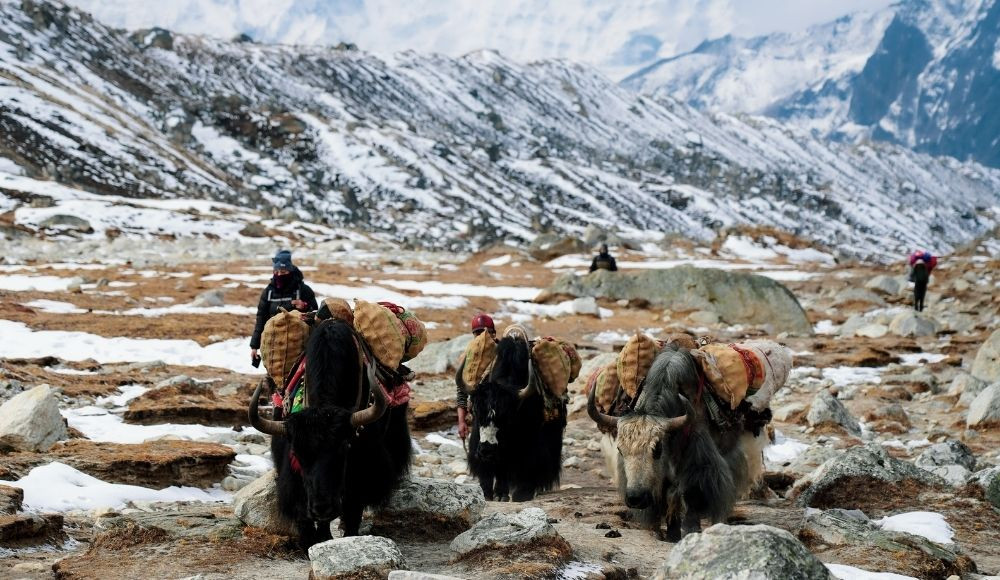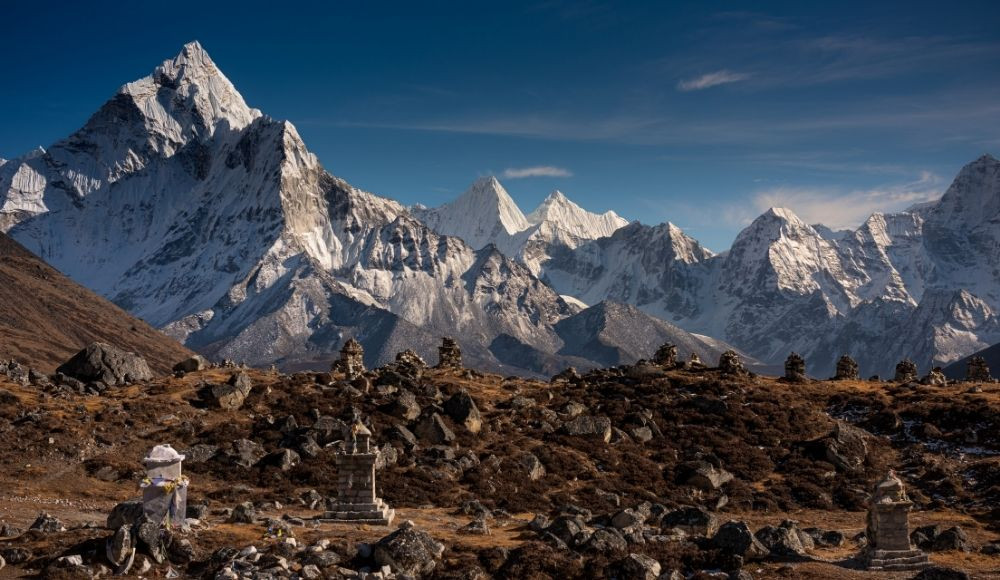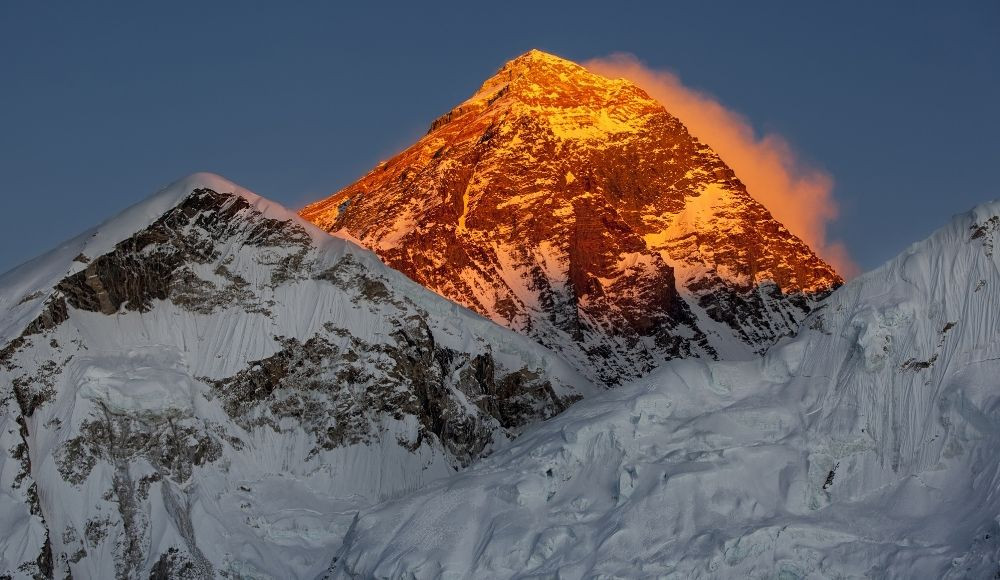Everest High Passes Trek
Trip Facts
Trip Highlights
- Museums and Monasteries like Sherpa museum, Tengboche monastery, Rimishung monastery, etc.
- Beautiful landscape that is not destroyed by the random road trails for vehicles.
- The heroes of the Himalayas - Sherpa Lifestyle, Tibetan Buddhism experience.
- Viewpoints like Kalapathar, Gokyo Ri, Everest view hotel, Renjo La top, and amazing Gokyo lakes.
- Pristine Gokyo lakes, memorials and beautiful valleys.
Trip Overview
The Everest High Passes Trek is a trek that takes you through the high mountain areas, which have passes climbing up to or over 5000 meters. Trekking in the Everest region of Nepal is an act of joy that is full of adventure and spirituality. If you are planning to trek in the high elevation slopes of Nepal, consider trekking to the Everest High Passes Trek. It will fascinate you with the incredible mountain panoramas, and a mix of culture and traditions followed by the legendary Sherpas.
The trekking area of the Everest region became world-renowned as an audacious mountain to climb. This famed mountain is further beguiled for being the world’s highest point and the incredible landscapes that are truly awe-inspiring for the adventure geeks.
Mount Everest stands as a common symbol of accomplishment. It represents human achievement and exploration, as well as all aspects of life: pleasure, pain, love, and death. The snow-capped peak has always beckoned adventurers to reach its summit from base camp, ever since Sir Edmund Hillary and Tenzing Norgay conquered the mountain in 1953. Today, trekkers from all over the world continue to answer the call of Everest by making their way across the rugged trails to the foot of Mount Everest and its glacial region.
The Everest High Passes Trek could answer all the tales that had become an inspiration, while some may have counted the tragedies. There are many interesting tales that are built and stored in the incredible mountain setting of Everest. Rainbow valley is where the most mountain casualties can be discovered while many had unfulfilled dreams to pursue the expedition adventure.
This trek takes you to the virgin Gokyo valley and some notable high-altitude mountain passes. You can explore the majestic Himalayan vistas and enjoy the authenticity that this high part of the world presents. If you are wondering about taking in the adventure on Everest, you can elongate the trek to the Gokyo valley while passing through three notable mountain passes in the region. This trek definitely will fascinate you, provide you with the ultimate thrill and reward you with adrenaline-inducing experiences, that too piously from the land of snow-capped Himalayas.
Fact Table
|
Trek |
Everest High Passes Trek |
|
Trek Type |
Teahouse and Lodge Trek |
|
Duration |
19 Days |
|
Highest Elevation |
5644 m. at Kala Patthar |
|
Start/Finish |
Kathmandu |
|
Difficulty |
Strenuous |
|
Total Trekking Distance |
150 - 220 KM |
|
Best Time to Trek |
|
|
Accommodation |
Lodges |
|
Average Trekking Per Day |
6-7 Hours |
|
Permits Required |
|
|
Route: Kathmandu - Lukla - Phakding - Namche Bazaar - Debuche - Dingboche - Chhukung - Lobuche - Gorakshep - Dzongla - Thannag - Gokyo - Lunde - Thame - Namche - Lukla - Kathmandu |
|
Everest Base Camp
Everest Base Camp is located on the south side of Mt. Everest at an altitude of 5364 meters. It is also one of the important marks in the Everest region. The base features mountaineering activities, resembling the hub of the mountaineers before embarking on an expedition. It is a top-notch destination for trekking enthusiasts, and a place venerated in the adventure arena.
Nestled between the mountains and the highest mountain in the world, Everest Base Camp (EBC) is not only a source of wonder for those who visit it but also attracts some of the greatest mountaineers on Earth. It is a humble collection of the Khumbu Himalayas with beautiful views.
On the south side, EBC has the mountain of Cho Oyu which is the sixth highest peak in the world. More importantly, though, is that it is not possible to see Everest from here, hiking up to the Kala Patthar allows you to see this incredible mountain. This makes it worth going up to the Kala Patthar viewpoint at least once during your trek. If you are planning to trek to the Everest Base Camp, then pick our Everest Base Camp Trek to have a delightful adventure experience. Also, if you want to visit Everest quicker, our Everest Base Camp Helicopter Tour would make your trip shorter and to the point. Also, if you want to take a quick flight tour of the Khumbu region within an hour, our Everest Mountain Flight is the best option that brings a wonderful opportunity to make use of time while witnessing the majestic mountain panorama. The spring and Autumn are the best time to trek to the Everest Base Camp.
Sherpa Culture and Lifestyle
Nepal is home to extraordinary ethnic and religious diversity. The country is split geographically into three regions: the fertile tundra of the northern hills, forests and tea plantations in the central mountains, and rice-growing plains in the south. But before you go rushing off to buy your plane ticket to trek in the Khumbu Himalayas, consider what it’s like for this exotic country’s Sherpas - their lifestyles and culture and traditions.
The trekking culture in Nepal is really interesting and you will find yourself learning a lot along the way. The villages are not sophisticated but the local Sherpas are happy to welcome tourists. They will be amazed by the fact that you come from where they have never been and they will share stories of how they were the first in their family to go to school and even how they were the first in their village to own a mobile phone. Mostly their lives depend on tourism and mountaineering activities. The local economy is pretty interesting because there are no roads into these villages so everything is carried on mules, horses or yaks.
Namche Bazaar
Namche Bazaar is a rustic market town in the Khumbu region of Nepal, situated at an altitude of 3440 meters. It is also known as Gateway to the Everest region of Nepal. From here you can access not just some really amazing trails but also fantastic peaks, lakes, forests and glaciers. Namche Bazaar represents the gateway to the Sagarmatha National Park, within which lies some of the most fascinating and glorious sights in Nepal. It also has a rich cultural heritage related to Buddhist traditions and Sherpa culture. Thus, Namche is a perfect place for travellers to stop over, stock up on supplies and take a break from long treks around the region. During the Everest High Passes Trek, you will be acclimatizing at this place and exploring the amazing scenery in this sherpaland. There are several monasteries, museums and sherpa cultural settlements.
For an acclimatization hike, you can go up to the Everest View Hotel. There you can enjoy the scenery and explore some incredible mountain panoramas. The mountain views of Pumori, Everest and several surrounding peaks. There are many other attractions to explore in this beautiful trekking area.
Sagarmatha National Park
Sagarmatha National Park, located in the Himalayan mountains of eastern Nepal, is the highest altitude National Park in the world. It was established to protect the area's biodiversity, including snow leopards and other endangered species such as red pandas and wild cats. Sagarmatha National Park includes Mount Everest, the highest mountain in history.
Between two tundra zones is the buffer zone, which includes the temperate to rival zone and is home to a diverse range of plants and animals. Lower elevations of the park have rhododendron scrub, blue pine, and hemlock woods. At higher altitudes, alpine vegetation such as silver fir, juniper, and birch are typical. There are approximately 865 species in this region, 64 of which are unique, making it important globally.
There are few animal species in this area because it is Himalayan in origin and frequently frigid. Thirty invertebrate species, eight reptile species, seven amphibian species, and one bird species are at risk of extinction in the area. In this region, 219 different bird species have been documented, including the crimson-faced snow cock.
Three High Passes
It is a spectacular and challenging three-pass route that begins at the Kongma La Pass and leads to base camp. Your first visit will be Kongmo La, where you can admire all the lovely prayer flags, chortens, and a stunning vista of Makalu. Following Kala Patthar, you will arrive at the Cho La pass. The best view of Everest and Ama Dablam with clean air is found on this stretch of route, which is also the most challenging. The most accessible crossing, Renjo la Pass, offers a stunning view of Cho Oyu and Everest.
While Mount Everest may be seen from a number of vantage locations, Kalapthhar offers the most breathtaking and magnificent view. Enjoy the picturesque panoramic views of the mountains from Kala Patthar. The Everest Three Passes Trek, albeit similar to the high passes trek is one of the best trekking routes in the Everest region of Nepal.
Gokyo Lakes
Located in the Khumjung Village Development Committee of the Solukhumbu district, the Gokyo Lakes are located in the northeastern portion of the Sagarmatha Zone. There are about 19 glacial lakes in the Gokyo Lakes, with Thonak Cho having the biggest area at 65.07 Ha.
Dudh Pokhari is the primary lake in Gokyo. It is sometimes referred to as Gokyo Cho. On the eastern side of Gokyo Cho the local village is located. Thonak Cho, Dudh Pokhari, Gyazumpa Cho, Tanjung Cho, and Ngojumba Cho are this lovely lake system's main lakes.
The Gokyo Lake system is extremely pristine, undeveloped, and features a complete natural community. It's the ideal setting to witness the most beautiful gift of nature in the Himalayas of Nepal.
The altitude of the Gokyo Lakes is between 4700 and 5000 meters above sea level. These lakes include some of the highest freshwater lakes on earth. Dudh Pokhari, one of the beautiful places to visit, is located at the height of 4750 meters. The Gokyo Glacial Lakes system consists of a number of lakes. This region's lakes have significant hydrological value. It is due to the watershed’s good environmental sustainability. This lake's water comes from seepage, streams, and a number of other sources.
Best time to Trek
Nepal is a country known for its favourable climate and friendly people. This travel destination has something to offer every traveller, from rich cultural heritage to numerous mountain ranges and amazing landscapes. So if you are in the mood for some adventure, trekking in Nepal is one of the best ways to explore this part of the world while being surrounded by stunning scenery. But before packing your bags, make sure you have a general idea of the best time to trek in Nepal.
Nepal is famous for its landscapes, which include the Himalayas, high-altitude valleys, active volcanoes and glacial lakes. On the other hand, the trekking season in Nepal is defined by a very specific period of the year. So make sure you know when to go to Nepal and what trekking season to choose. By knowing this information, you can have a greater chance of enjoying your time in Nepal.
The best time to trek in the Everest region of Nepal is actually a matter of personal preference. First of all, it depends on your choice of destination and the number of days you want to spend trekking. If you want to discover Nepal by trekking in the Everest region, then you may want to consider travelling from March to mid-May as this is when the period between winter and summer begins. This period features pleasant weather and less rain, which means that you will have plenty of clear skies for admiring the views surrounding you. The days of the trek will be more pleasant than those of the sixth month, but you can still expect some rain.
Overall, spring and autumn are the most favourable to trek in the Everest region. This is when the trekking season begins and offers ideal weather conditions and pleasant sunshine. Also, these months are a good time to visit Nepal as it features wonderful scenic beauty and stunning landscapes.
Detailed Itinerary
Arrival in Kathmandu
Trek Preparation, Heritage Sites Visit
Flight to Lukla, Trek to Phakding
Trek from Phakding to Namche
Acclimatization in Namche Bazaar
Trek from Namche to Debuche
Trek to Dingboche
Trek from Dingboche to Chhukung
Trek to Lobuche via Kong Ma La Pass
Trek to Gorak Shep and EBC, return to Gorakshep
Hike to Kala Patthar, Trek to Dzongla
Trek to Thannag via Cho La Pass
Trek to Gokyo, Exploration of Gokyo Ri
Trek to Lunde via Renjo La Pass
Trek from Lungde to Namche
Trek from Namche Bazaar to Lukla
Fly back to Kathmandu
Leisure in Kathmandu
Departure
Trip Guide
The given information about the Everest High Passes Trek is in-depth, feel free to contact us 24/7 for any kind of assistance. We will be available on WhatsApp to assist you instantly. You can write an email if this trip doesn't fit your vacation schedule and requirements. Altitude Himalaya aims to offer the best possible travel experience to the customers. Depending on the needs of the visitors and the group size, we customize each vacation package. We will put together a bespoke itinerary just for your private group.
Frequently Asked Questions
-
Who lives in the Everest region?
The Everest region is mostly inhabited by the Sherpa people. They are the major residents and mountain guides of the Everest region. The ethnic tribe is also a major role player in the expedition and mountaineering activities.
-
How difficult is Everest High Passes trek?
Everest High Passes trek is a moderately difficult trek in Nepal. The trekking to the Everest Base Camp is admired as it is one of the most iconic and fascinating trails in the world. Having good stamina and physical fitness helps a lot during trekking. However, it’s not mandatory that you have prior trekking experience.
-
Is the Everest High Passes trek worth it?
Yes, it is one of the most beautiful treks in the world. It takes you to the base of the highest point on earth. It is the ultimate destination for many mountaineers and trekking enthusiasts. It has been admired for its jaw-dropping beauty, cultural attractions and natural sceneries.
-
Are showers and washing facilities available on EBC Trail?
Yes, but it may incur extra charges. Since it is in a remote region, arrangements are pretty hard. So, the expenses are understandable.
-
What to carry during Everest High Passes Trek?
If you are planning to trek in the high mountains of Nepal, consider making your backpack light. It helps you a lot while trekking. Carry essential items and don't make your backpack too heavy. For trekking item recommendations, visit Nepal Trekking Gear Checklist.
-
What is the best climb Mount Everest?
The best time to climb Everest starts right after the beginning of April and lasts till May. It is considered one of the ideal periods to climb this legendary peak. For details, visit Best time to Climb Mount Everest.
Services Includes
- All arrival and departure at Kathmandu airport as mentioned.
-
Flight transfer between Kathmandu/Lukla/Kathmandu as mentioned in the itinerary.
-
3 star deluxe hotel accommodation in Kathmandu.
-
Luxury Lodge accommodation during the trek.
-
Daily breakfast throughout the trip.
-
Lunch and Dinner from trek start day to trek end day.
-
All necessary paperwork. (Required Permits)
-
An experienced and English/Hindi speaking licensed trekking guide.
-
Guide’s salary, food, accommodation and allowances.
-
Duffle bags to carry goods and trekking route maps – if necessary.
-
Farewell Nepali dinner on your last night in Kathmandu.
-
All government and local taxes.
-
Arrangement of emergency helicopter service which will be paid by the traveller's
-
insurance company. (Insurance is highly recommended)
Services Excludes
-
Personal expenses.
-
Kathmandu sightseeing entrance fee if there is Kathmandu sightseeing and additional stay.
-
Lunch and dinner in Kathmandu.
-
International flight ticket.
-
Travel health insurance. (highly recommended)
-
Tips for the guide, porter and driver.
-
Sweet things like dessert/chocolate.
-
Any alcoholic and non-alcoholic drinks.
-
Hot water, shower/batteries charge/heater during the trek.
-
Any other expenses which are not mentioned in the including section.
-
Porter during the trek. (a porter can carry around 20/22 KG of baggage)
Why Travel With Altitude Himalaya?
We believe in the quality services to accommodate our guests 360 degrees need with tour personalization and customization. Our dedicated and experienced team believes not only in arranging trips, but making creating life long memories. Our travel experience within the region of Nepal, Bhutan and Tibet could make a memorable trip of yours.
Confirm Your reservation Now


TALK TO AN EXPERT
we can help you find your perfect holiday
Mr. Kiran has experience of 10+ years in tourism across Nepal, Bhutan and Tibet holiday arrangements to thousands of travellers from around the world. He will help you to figure out the best possible vacation plan according to your choice and preference.







 Duration
19 days
Duration
19 days
 Trip Difficulty
Difficult
Trip Difficulty
Difficult
 Highest Point
5645 m.
Highest Point
5645 m.
 Trip Code
EHPT
Trip Code
EHPT
 Start Point
Kathmandu
Start Point
Kathmandu
 Trip End Point
Kathmandu
Trip End Point
Kathmandu
 Accomodation
As Mentioned
Accomodation
As Mentioned
 Meals
As mentioned
Meals
As mentioned
 Transportation
As mentioned
Transportation
As mentioned
 1350 M
1350 M
 4830 M
4830 M
 Send an email
Send an email +9779823000055
+9779823000055 +9779823000055
+9779823000055